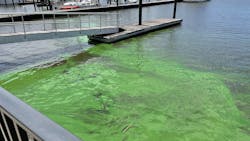Moleaer, Florida Gulf University announce algae treatment study
Moleaer, the leading nanobubble technology company, today announced a research collaboration with The Water School at Florida Gulf Coast University (FGCU) to study the impact of nanobubble technology on tackling harmful algae in a Lake Okeechobee marina.
This study starts today with Moleaer’s Clear nanobubble generators being installed in the Pahokee Marina in the City of Pahokee. In Florida, algal blooms have been increasing in number and severity as a result of increased nutrient loading and climate change. This marina has been selected because it is a microcosm of Lake Okeechobee and is prone to harmful algal blooms.
Dr. Rosen, a professor at The Water School at Florida Gulf Coast University, says, “I am testing this technology’s efficacy in the prevention and treatment of cyanobacterial blooms in the field. This study will allow a better understanding if we can push the algal community away from a harmful cyanobacteria bloom and towards one that has a balance of primary producers.”
Harmful Algae Blooms (HABs) have wide-ranging impacts on the environment, including negatively impacting aquatic life. These blooms can also contribute to fish deaths as a result of oxygen depletion. Several species can also impact local wildlife, pets, and even human health, ranging from allergies, skin irritation and headaches, and some of these toxins are potent toxins.
“We’re proud to partner with FGCU, the leading university on harmful algal blooms research. We have a shared understanding that the health of our aquatic ecosystems is vital to the lives and livelihoods of all people and living things,” says Nick Dyner, CEO of Moleaer. “This is an opportunity to further study and validate how nanobubbles can clean waterways on a larger scale.”
Nanobubbles are invisible to the naked eye and 2,500 times smaller than a single grain of table salt. Bubbles at this scale remain suspended in water for long periods, enabling highly efficient oxygen transfer and a supersaturation of dissolved gas in liquids. This oxygenation can reduce and prevent contaminants such as algae, algae toxins, pathogens, and other organic materials.
This study is being funded by a $355,850 grant from Florida’s Department of Environmental Protection provided to Dr. Rosen of The Water School at FGCU to study how nanobubbles can improve water quality, restore aquatic ecosystems, and prevent algal blooms in the local waterways.
SOURCE: Moleaer, via Yulu Public Relations
